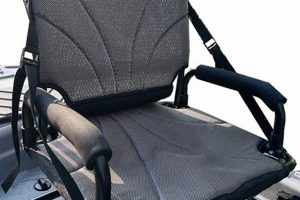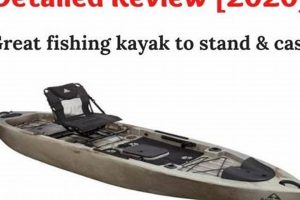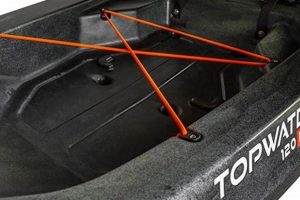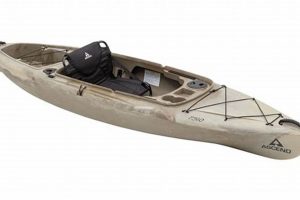Specialized angling equipment designed for use from kayaks in marine environments typically features shorter lengths for easier handling in the confined space of a kayak cockpit. These rods are often constructed from durable, corrosion-resistant materials like graphite or fiberglass, and equipped with features such as adjustable reel seats and comfortable grips. Collapsible or two-piece designs are also common for convenient storage and transport.
Compact angling equipment enables anglers to access shallow-water fishing grounds and explore diverse coastal habitats often inaccessible to larger vessels. This approach offers a unique and immersive angling experience, promoting closer contact with nature. Historically, coastal communities have utilized small watercraft for fishing, adapting their methods and equipment to suit the challenges and opportunities presented by the marine environment. Modern advancements in materials and design have further refined the tools available, enhancing both performance and portability.
The following sections will explore the key characteristics of these specialized rods, including length, action, power, and material construction. Furthermore, appropriate reel pairings, line selection, and essential accessories will be discussed to provide a comprehensive guide to outfitting anglers for successful kayak fishing excursions.
Tips for Kayak Fishing Rod Selection
Choosing appropriate equipment is crucial for a successful and enjoyable kayak fishing experience. Several factors must be considered to ensure the rod complements both the angler’s style and the targeted species.
Tip 1: Prioritize shorter rod lengths. Rods ranging from 6 to 7.5 feet offer optimal maneuverability within the limited space of a kayak.
Tip 2: Consider rod action. A fast action rod tip provides greater sensitivity for detecting bites and setting hooks quickly, particularly beneficial for smaller fish. Moderate or slower action rods offer increased flexibility for battling larger species.
Tip 3: Match rod power to target species. Lighter power rods (medium-light to medium) are suitable for smaller fish, while heavier power rods (medium-heavy to heavy) are necessary for larger, more powerful fish.
Tip 4: Choose durable and corrosion-resistant materials. Graphite and fiberglass composite blanks offer a balance of strength, sensitivity, and resistance to the harsh saltwater environment.
Tip 5: Evaluate reel seat and grip design. A secure and comfortable reel seat and grip enhance control and reduce fatigue during prolonged fishing sessions.
Tip 6: Opt for collapsible or two-piece rods. These designs facilitate convenient storage and transport, essential considerations for kayak anglers.
Tip 7: Consider rod guides. Stainless steel or titanium guides with corrosion-resistant inserts are essential for saltwater fishing.
Careful consideration of these factors ensures anglers select equipment optimized for kayak fishing, enhancing both performance and enjoyment on the water.
By understanding these key elements, anglers can confidently choose equipment well-suited to their specific needs and target species, ultimately leading to a more rewarding and successful kayak fishing experience.
1. Length
Rod length is a critical factor in kayak fishing, directly impacting casting ease, fish fighting ability, and overall maneuverability within the confined space of a kayak cockpit. Choosing the correct length balances these considerations to optimize angling performance.
- Maneuverability
Shorter rods, typically between 6 and 7.5 feet, excel in kayak fishing due to their enhanced maneuverability. The limited space within a kayak necessitates compact equipment. Longer rods become cumbersome and difficult to manage, particularly when paddling, landing fish, or navigating tight spaces. Shorter rods allow for greater control and precision in casting and retrieving, crucial for successful kayak angling.
- Casting Distance
While longer rods generally offer increased casting distance, the benefits are less pronounced in kayak fishing. Shorter rods, when paired with appropriate casting techniques, can achieve sufficient casting distances for most kayak fishing scenarios. The trade-off for slightly reduced casting distance is significantly increased maneuverability, a critical factor in kayak angling.
- Fish Fighting Ability
Shorter rods provide increased leverage and control when battling fish, particularly in close quarters. This leverage advantage compensates for the shorter length, allowing anglers to effectively manage larger fish from a kayak. The increased control and lifting power offered by shorter rods are valuable assets when fighting strong fish in a confined environment.
- Storage and Transportation
Shorter rods offer practical advantages for storage and transportation. They fit more easily within kayak hatches or can be secured to the deck without interfering with paddling. This convenience is further enhanced by collapsible or two-piece rod designs, making transport to and from the water easier.
The optimal rod length for kayak fishing often represents a compromise between casting distance and maneuverability. While longer rods offer a slight edge in casting, the enhanced control, leverage, and ease of handling provided by shorter rods are essential for a positive and productive kayak fishing experience.
2. Action
Rod action, referring to the rod’s bending profile when under pressure, significantly influences fishing techniques and effectiveness. Understanding action is crucial for selecting appropriate equipment tailored to target species and fishing style in a sea kayak environment.
- Fast Action
Fast action rods bend primarily in the top third, providing increased sensitivity for detecting subtle bites and enhanced hook-setting power. This action excels with techniques requiring precise lure control and immediate hooksets, such as jigging or fishing with topwater lures. The quick recovery rate of a fast action rod also aids in accurate casting in the confined space of a kayak. However, the stiffer tip may not absorb the shock of a strong fish as effectively, requiring careful line management.
- Moderate Action
Moderate action rods bend in the top half, offering a balance between sensitivity and fish-fighting power. This versatile action suits various fishing styles and target species, providing adequate sensitivity for bite detection and sufficient flex to absorb the runs of larger fish. Moderate action rods are well-suited for kayak fishing applications where a compromise between casting performance and fish-fighting capability is desirable.
- Slow Action
Slow action rods bend throughout their length, offering maximum flex and shock absorption. This action excels when battling large, powerful fish, reducing the risk of line breakage and providing a smoother fight. However, the slower recovery rate can hinder casting accuracy and sensitivity for detecting subtle bites. While less common for kayak fishing, slow action rods find application when targeting exceptionally large species from a kayak.
- Extra Fast Action
Extra fast action rods offer the utmost sensitivity and rapid hooksetting power, bending primarily at the very tip. This action is ideal for techniques requiring pinpoint accuracy and immediate reaction to bites, such as finesse fishing or working small jigs. In a sea kayak, extra fast action can be advantageous for targeting smaller, more elusive species or fishing in clear, shallow water where stealth is paramount.
Selecting the appropriate rod action for sea kayak fishing requires careful consideration of target species, fishing style, and personal preference. Understanding the characteristics of each action category empowers anglers to choose equipment optimized for their specific needs and maximize their chances of success on the water.
3. Power
Rod power, a measure of a rod’s lifting strength, is a critical factor influencing an angler’s ability to effectively handle fish from a sea kayak. Matching rod power to target species and fishing conditions ensures successful hooksets, controlled fights, and ultimately, landing the catch. Selecting an appropriate power rating is essential for optimizing angling performance in the dynamic sea kayak environment.
- Ultra-Light to Light Power
Ultra-light and light power rods are designed for smaller fish species and lighter lines. These rods offer exceptional sensitivity for detecting subtle bites and provide a thrilling fight even with smaller fish. However, their delicate construction makes them less suitable for battling larger, more powerful species or handling heavier lures and terminal tackle typically used in offshore kayak fishing.
- Medium-Light to Medium Power
Medium-light and medium power rods offer a versatile balance suitable for a wider range of species and fishing techniques commonly employed from sea kayaks. These rods provide sufficient strength for handling moderately sized fish while retaining adequate sensitivity for detecting bites. They are well-suited for inshore kayak fishing targeting species such as speckled trout, redfish, or snook.
- Medium-Heavy to Heavy Power
Medium-heavy and heavy power rods provide the necessary strength and backbone for targeting larger, more powerful gamefish often encountered in offshore kayak fishing environments. These rods can handle heavier lines, larger lures, and the powerful runs of larger pelagic species. However, their increased strength often comes at the expense of sensitivity for detecting lighter bites.
- Matching Power to Target Species and Conditions
Matching rod power to the target species and prevailing conditions is paramount for successful kayak angling. Using an underpowered rod risks line breakage and losing fish, while an overpowered rod may diminish the sport of the fight and hinder sensitivity. Consider the typical size and fighting ability of the target species, as well as the potential for encountering larger, unexpected catches when selecting an appropriate power rating. Factors such as current strength and wind conditions also influence the required rod power. Stronger currents and winds necessitate heavier tackle to maintain control and effectively present lures or bait.
Careful consideration of rod power ensures effective hooksets, controlled fights, and ultimately, a higher landing ratio. Selecting the correct power for the anticipated fishing conditions and target species is crucial for optimizing angling performance and maximizing the enjoyment of sea kayak fishing excursions.
4. Material
Rod material significantly influences performance characteristics, durability, and overall suitability for the demanding saltwater environment encountered in sea kayak fishing. The choice of material affects factors such as weight, sensitivity, strength, and resistance to corrosion, all crucial considerations for anglers seeking optimal performance and longevity in their equipment.
Graphite, a popular choice for rod construction, offers a desirable combination of lightweight sensitivity and strength. Its inherent stiffness transmits vibrations effectively, allowing anglers to detect subtle bites and maintain precise lure control. High-modulus graphite further enhances sensitivity and responsiveness but can be more brittle than lower-modulus options. Fiberglass, another commonly used material, provides excellent durability and affordability. While generally heavier than graphite, fiberglass offers superior impact resistance and resilience, making it well-suited for challenging fishing environments. Composite constructions, blending graphite and fiberglass, seek to combine the advantages of both materials, offering a balance of sensitivity, strength, and durability.
Corrosion resistance is paramount for sea kayak fishing rods due to constant exposure to saltwater. Rod components, including guides, reel seats, and ferrules, must withstand the corrosive effects of saltwater to maintain functionality and prolong lifespan. Stainless steel guides with corrosion-resistant inserts, such as ceramic or titanium oxide, are essential for saltwater applications. Reel seats constructed from anodized aluminum or graphite composite materials offer enhanced corrosion resistance compared to traditional aluminum. Selecting materials that can withstand the harsh marine environment ensures the longevity and reliable performance of sea kayak fishing rods. Understanding the properties of various rod materials allows anglers to make informed decisions when selecting equipment tailored to their specific needs and fishing style. Balancing factors such as sensitivity, strength, durability, and corrosion resistance ensures optimal performance and long-term satisfaction in the challenging sea kayak fishing environment.
5. Portability
Portability is a paramount consideration for sea kayak fishing rods, given the inherent limitations of space and the need for efficient transport and storage. Rod designs must balance performance with convenient handling and stowage, ensuring they integrate seamlessly with the kayak fishing experience. Compromising portability can hinder maneuverability and overall angling efficiency in the challenging sea kayak environment.
- Collapsible or Multi-Piece Designs
Collapsible or multi-piece rods offer significant advantages in portability, reducing overall length for convenient storage and transport. These designs typically feature ferrules or joints that connect rod sections securely. While some anglers express concerns about potential weak points at these junctions, modern manufacturing techniques and materials have significantly improved the strength and reliability of multi-piece rods. Collapsible designs are particularly beneficial for kayak anglers who may need to navigate through dense vegetation, transport their kayaks on roof racks, or store equipment in limited spaces.
- Compact Rod Lengths
Shorter rod lengths inherently contribute to portability, facilitating easier handling within the confined space of a kayak cockpit. Rods ranging from 6 to 7.5 feet generally strike a balance between casting performance and maneuverability in a kayak. Compact rod lengths also simplify storage and transport, allowing anglers to efficiently pack and secure their equipment. This is particularly important when navigating challenging terrain or transporting kayaks on vehicles.
- Lightweight Construction
Lightweight rod construction enhances portability by reducing overall weight and fatigue during prolonged fishing trips. Materials like graphite composite offer a desirable balance of strength and reduced weight, minimizing strain during casting and retrieving. Lightweight rods also contribute to overall kayak balance and stability, important factors for safety and maneuverability, especially in challenging sea conditions.
- Storage and Transport Solutions
Dedicated storage and transport solutions further enhance the portability of sea kayak fishing rods. Rod sleeves or tubes protect rods during transport and storage, preventing damage to delicate components like guides and tips. Kayak-specific rod holders and storage systems secure rods within the kayak, maximizing deck space and ensuring easy access during fishing. These solutions streamline the logistics of transporting and managing fishing equipment in a kayak setting.
Prioritizing portability in sea kayak fishing rod selection ensures a seamless and efficient angling experience. By carefully considering rod length, design, weight, and storage solutions, anglers can maximize both on-the-water performance and ease of transport, allowing for a more focused and enjoyable kayak fishing adventure.
6. Durability
Durability is a critical factor for sea kayak fishing rods, given the harsh marine environment and the potential for impacts and abrasion. Rods must withstand exposure to saltwater, UV radiation, and physical stresses inherent in kayak fishing. A durable rod ensures reliable performance over time, minimizing the risk of failure during critical moments and reducing the need for frequent replacements.
- Material Selection
Rod material significantly influences durability. Graphite composites offer a balance of strength and light weight, but higher-modulus graphite can be more brittle. Fiberglass rods provide excellent impact resistance, while composite blends seek to combine the benefits of both materials. Selecting materials resistant to saltwater corrosion and UV degradation is essential for ensuring long-term performance.
- Component Construction
Guide quality and construction play a vital role in rod durability. Stainless steel guides with corrosion-resistant inserts, such as ceramic or titanium oxide, are crucial for saltwater environments. Reinforced ferrules and joints in multi-piece rods enhance strength and prevent breakage at connection points. Durable reel seats, constructed from anodized aluminum or corrosion-resistant composites, contribute to overall rod longevity.
- Protective Coatings and Finishes
Specialized coatings and finishes enhance rod durability by providing a protective barrier against saltwater, UV radiation, and abrasion. Epoxy-based finishes protect blank materials, while corrosion-resistant coatings on guides and other components minimize the detrimental effects of saltwater exposure. These protective layers safeguard the rod’s structural integrity and maintain its appearance over time.
- Maintenance Practices
Proper maintenance practices are essential for preserving rod durability. Rinsing the rod with freshwater after each use removes saltwater residue and minimizes corrosion. Regularly inspecting guides for damage and replacing worn components prevents further wear and tear. Proper storage, avoiding excessive bending or exposure to extreme temperatures, also contributes to long-term rod health.
Investing in a durable sea kayak fishing rod minimizes the risk of equipment failure and ensures reliable performance throughout numerous fishing expeditions. Selecting rods constructed from robust materials, featuring high-quality components, and protected by specialized coatings contributes to long-term durability and reduces the need for frequent replacements. Combined with diligent maintenance practices, these factors contribute to a dependable and resilient fishing tool capable of withstanding the rigors of the sea kayak environment.
Frequently Asked Questions
This section addresses common inquiries regarding specialized fishing rods designed for sea kayaks, providing concise and informative responses to aid selection and usage.
Question 1: What is the ideal length for a sea kayak fishing rod?
Lengths between 6 and 7.5 feet generally offer the best balance of maneuverability and casting performance in a kayak’s confined space. Longer rods can be cumbersome, while shorter rods sacrifice some casting distance.
Question 2: How does rod action influence sea kayak fishing?
Rod action dictates the rod’s bending profile. Fast action provides sensitivity for detecting bites and quick hooksets, ideal for smaller fish and techniques like jigging. Moderate action offers a balance between sensitivity and fish-fighting power. Slower action excels with larger fish but sacrifices some casting accuracy. The choice depends on target species and fishing style.
Question 3: Which rod power is suitable for sea kayak fishing?
Rod power refers to lifting strength. Medium-light to medium power is versatile for inshore kayak fishing, handling moderately sized fish. Medium-heavy to heavy power is necessary for larger offshore species. Matching rod power to target species prevents line breakage and ensures effective fish fighting.
Question 4: What materials are best suited for sea kayak fishing rod construction?
Graphite composites offer a balance of sensitivity, strength, and light weight. Fiberglass provides exceptional durability and affordability. Corrosion-resistant components, like stainless steel guides with ceramic or titanium oxide inserts, are essential for saltwater environments.
Question 5: Why is portability important for sea kayak fishing rods?
Kayaks have limited storage space. Collapsible or two-piece rods facilitate transport and storage. Shorter lengths and lightweight construction also enhance portability, crucial for maneuvering and navigating with the kayak.
Question 6: How can one ensure the durability of a sea kayak fishing rod?
Selecting rods constructed from corrosion-resistant materials, featuring durable components like guides and reel seats, and employing protective coatings enhances longevity. Regular maintenance, including rinsing with freshwater after use, further extends rod lifespan.
Careful consideration of these factors ensures selection of equipment optimized for the unique demands of sea kayak fishing, promoting both success and enjoyment on the water.
The subsequent section delves further into specific rod recommendations tailored to various sea kayak fishing applications, offering practical guidance for anglers equipping themselves for this specialized pursuit.
Conclusion
Specialized fishing rods designed for sea kayaks represent a critical intersection of functionality, portability, and durability. Optimal performance in the dynamic marine environment necessitates careful consideration of factors such as rod length, action, power, material composition, and design features that enhance both maneuverability and resilience. Choosing appropriate equipment tailored to target species and fishing style significantly impacts angling success and overall enjoyment on the water.
The evolving landscape of kayak fishing continues to drive innovation in rod design and technology. As anglers explore increasingly diverse and challenging waters, the demand for specialized equipment capable of withstanding the rigors of the marine environment while maintaining optimal performance will persist. A thorough understanding of these specialized rods empowers anglers to make informed decisions, equipping them to fully embrace the rewarding challenges and unique opportunities presented by sea kayak fishing.






